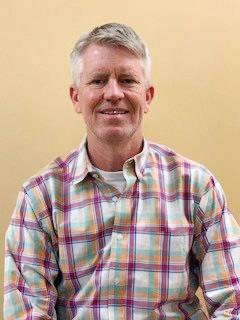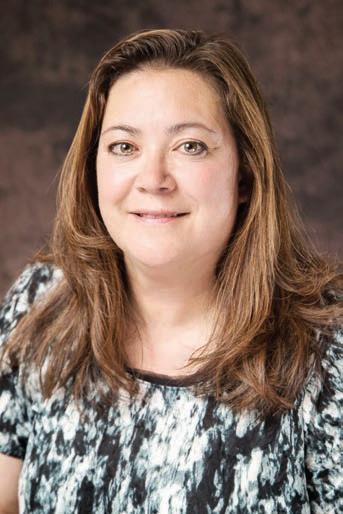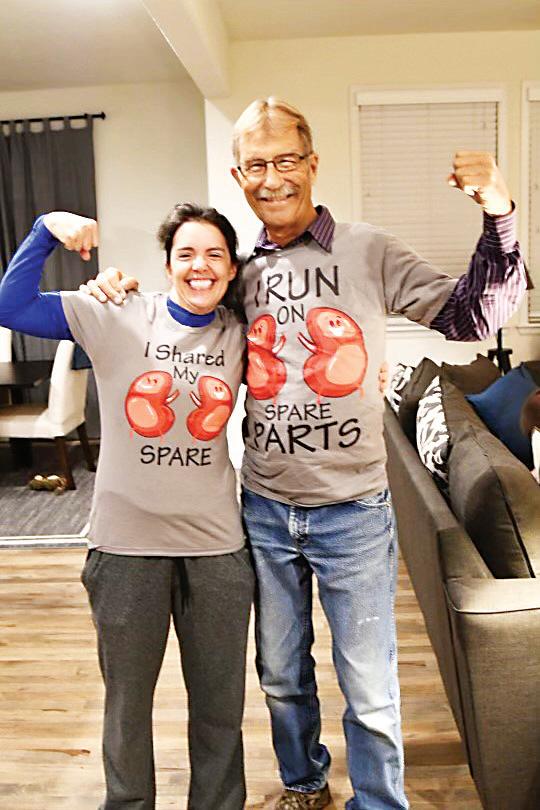
27 minute read
LOCAL
Health o cials recommend domestic animals get vaccinated
BY BELEN WARD BWARD@COLORADOCOMMUNITYMEDIA.COM
Authorities found two rabid skunks on properties south of Greeley on March 11 and 14 according to the Weld County Department of Public Health and Environment.
“Weld County is a hot spot for rabies; we encourage residents to get your animals vaccinated. If an animal is unvaccinated and is infected with rabies, the animal would have to be euthanized,” said Lisa VanBerg, Fort Lupton Animal Control.
“Fort Lupton requires residents to register your dog for a city license at no charge. You must bring proof of the rabies vaccination to register. And the vaccination tag must be displayed.”
The skunks got into a run-in with dogs at each property, so the owners turned over the skunks to the WCDPHE laboratory, and results came back on March 14th and March 16th positive for rabies. The two dogs were rabies vaccinated.
According to health offi cials, if rabies is left untreated, it’s 100% fatal. Colorado bat and skunks are the two leading carriers of rabies, but not all skunks are infected with rabies. If a skunk is spotted in daylight acting strangely, lying on the ground, or physically paralyzed and acting aggressively, it could be sick with rabies.
Christine Bevel Environmental Specialist (WCDPHE), said, “If we are aware of the dogs history and is unvaccinated we can isolate the dog for several days and give them a series of vaccinations to save the pet. But if the animal has already developed the rabies they would have to be euthanized.”
Wild animals such as foxes, skunks, raccoons, coyotes, and bats could also get infected with rabies. Health offi cials recommend a rabies vaccination on all domestic animals such as cats, dogs, horses, and livestock.
Within the past several years, humans have come in contact with rabies, which requires an immune globin and vaccine post-exposure treatment of rabies. A vaccination treatment is available to treat rabies before symptoms appear. In Weld County, there are no reported human deaths from rabies infection according to health offi cials.
Rabies is a virus that attacks the nervous system and causes infl ammation of the brain and spinal cord, which could be fatal. According to health offi cials, transmission is from the saliva of an infected animal or through an open wound, cut, or scratch.
To prevent exposure to rabies:
Do not feed, touch, or handle any wild animals.
Ensure dogs, cats, horses, and livestock are regularly vaccinated livestock by a licensed veterinarian.
Keep a close eye on any new puppy or kitten while outdoors until it has received the rabies vaccine for 28 days.
Spay or neuter pets to reduce the number of unwanted or stray animals in the neighborhood.
Contact WCDPHE at 970 400-2290 for questions or if anyone or their pets has had contact with a skunk. For after-hours outside of 8:00 a.m. - 5:00 p.m., Monday-Friday, contact Weld County Dispatch at (970) 3509600 and select option 4.


New tra c signal could be online by end of the month
BY STEVE SMITH SSMITH@COLORADOCOMMUNITYMEDIA.COM
The city of Brighton said work on a controlled signal at East 144th Avenue and Sable Boulevard is in the last phase.
A Fort Morgan baseball coach died in a crash at that intersection almost three years ago. That prompted the call for a controlled traffi c signal at all four corners. The city said the project is about 85 percent complete.
City spokesperson Linda Ong said the project consisted of two phases. The fi rst part was underground infrastructure, followed by burying overhead power lines because of confl icts. The second phase — and the most visible to traffi c — is the installation of the signals and other infrastructure.
“Last week, the contract team completed the installation of the traffi c signal poles,” Ong said. “The team will be installing the traffi c signal components over the next week and begin testing the signal. The fi nal components include items such as the traffi c signal heads, signage, guardrail, traffi c signal controller cabinet, and other similar components.”
Ong said the signal should be fully operational by the end of the month. Before that, the signal’s use starts with a fl ash test for several days.
“We ask the public to please use caution while construction is fi nalizing and slow speeds when approaching traffi c control to keep our team safe,” Ong said. “Additionally, be prepared for the change of fl ow in traffi c and the new confi guration as the transition from a four-way stop is made to a signalized intersection.”
MARIJUANA
“I wasn’t surprised,” Hooton, who has brought similar legislation for several years, said of the outcome. “I got a lot of very, very valuable feedback about how we might be able to move forward in the future.”
The question of whether the use of cannabis off the clock can disqualify a person for a job or lead to their fi ring has been swirling in Colorado since voters passed Amendment 64 in 2012, which legalized the sale and use of recreational cannabis. Most states that have lifted prohibitions on pot leave the question of how to handle employees’ marijuana use up to employers, according to the National Conference of State Legislatures.
Nevada and New Jersey are two exceptions. In New Jersey, employers can prohibit employees from using cannabis while on the job or from showing up to work impaired. But they are not allowed to penalize an employee solely because of their offthe-clock recreational cannabis use.
In 2015, the Colorado Supreme Court sided with Dish Network, which fi red an employee, Brandon Coats, after he tested positive for tetrahydrocannabinol – or THC – in a random drug test. Coats had a medical marijuana card as a result of back spasms caused by his quadriplegia. Muscle spasms are one of the seven debilitating conditions for which medical marijuana can be recommended under Colorado law.
The closely watched case highlighted Colorado’s pot paradox: Marijuana is legal but consuming it can still be grounds for termination.
Amendment 64 included the following provision: “Nothing in this (ballot measure) is intended to require an employer to permit or accommodate the use, consumption, possession, transfer, delay, transportation, sale or growing of marijuana in the workplace to affect the ability of employers to have policies restriction the use of marijuana by employees.”
Amendment 20, the 2000 ballot initiative allowing medical marijuana sales and use in Colorado, included a provision about how it does not “require any employer to accommodate the medical use of marijuana in any workplace.”
This story is from The Colorado Sun, a journalist-owned news outlet based in Denver and covering the state. For more, and to support The Colorado Sun, visit coloradosun.com. The Colorado Sun is a partner in the Colorado News Conservancy, owner of Colorado Community Media.
PAID ADVERTISEMENT
Don’t be surprised by Social Security taxes
When you apply for your Social Security retirement benefits, you need to think about how much you want withheld for taxes. Many people overlook this issue – only to face an unpleasant surprise at tax time, because Social Security benefits may be added to taxable income.
Using Form W-4V, you can have 7, 10, 12 or 22 percent of your monthly benefit withheld. Your tax advisor can help you choose the appropriate percentage.
And you have other ways to control the taxes due on your benefits. For example, if you meet certain conditions, withdrawals from a Roth IRA will not be taxed, so they won’t increase your taxable income or your Social Security taxes.
Also, the earlier you take Social Security, the lower your monthly payments, and the lower the taxes. Still, taxes shouldn’t determine when you want to start taking payments – instead, consider other factors, such as your life expectancy, your employment situation, your spending needs and the benefits for your spouse.
The more you know about the impact of Social Security benefits on your taxes, the better prepared you’ll be to incorporate these benefits into your retirement income plans.
This article was written by Edward Jones for use by your local Edward Jones Financial Advisor.
www.edwardjones.com Member SIPC


National Doctors Day honors doctors
BY BELEN WARD BWARD@COLORADOCOMMUNITYMEDIA.COM
COVID-19 did a lot of things to a lot of people, but three local doctors said it sharpened their focus on why they chose medicine as a profession.
“It made the world vulnerable, even mistrusting, yet brought some of us together more. It depends on how you want to view it and handle change,” said Brighton OB/GYN Oralee Ekberg.
Platte Valley Medical Center brought the three together in honor of National Doctors Day, March 30. The day, signed into law in 1991 by President George H.W. Bush, recognizes doctors across the nation in appreciation for their dedication to saving lives and a celebration of medical advances.
We asked three doctors at Platte Valley Medical Center – Ekberg, Medical and EMS Director Candace Harrod and internal medicine and pulmonary doctor Shad Grubbs – to share their stories.
Right direction
When Ekberg, an OB/GYN in Brighton, decided to go to medical school late in her career, she felt it was the right direction.
“I remember shadowing an orthopedic surgeon in Boulder, and he suggested that I go work in the medical fi eld for a year and make sure that I really like it,” said Ekberg.
Ekberg attended the Osteopathic Medical School in Kansas City graduating in 1998 and fi nishing her residency in 2003.
“It was diffi cult, but I studied, trained, and learned what I needed to do for my job,” Exberg said.
Her fi rst job in Brighton was at Brighton Community Hospital on Egbert Street, and it was that experience -- good and bad -- that shaped her into the doctor she is today. What she loves most about being a doctor is meeting women every day and learning about parts of their lives.
During COVID, Ekberg was not on the frontlines as a GYN doctor. Ekberg said her colleagues dealt more with the women in labor who were positive for COVID, monitoring them for delivery and the virus’s symptoms. The impact of the virus caused anxiety for the medical staff.
“It really had no boundaries, and even if you did not get the virus, we all knew someone was affected in some way by COVID’s devastation. So, the past two years did play havoc on everyone’s psyche,” said Ekberg.
Ekberg looks forward to things she will learn, meet people, and continue to grow to be a better doctor. She is also focusing on raising her children into their journeys of adulthood.
“I really do love what I do, whether I am at the offi ce or in the operating room, I am happy and proud of my career choice,” said Ekberg.
Loved a challenge
A few sports orthopedic surgeries in high school inspired Harrod to go into physical therapy or become a doctor. When she attended medical college in Georgia in 2002, she did some volunteer work and chose medicine. She has been a physician for 21-years.
“I have always loved a challenge that medicine provided. I enjoy the lifelong learning required to be a physician,” said Harrod.
She remembered her fi rst shift working in the emergency department as an emergency medicine intern.
“I was thinking it’s was going to be a wild ride. It certainly has lived up to more than I anticipated,” she said.
While working in the emergency department, Harrod had many particular patients with every type of situation, and it can also be emotional.
“Some are lives saved, and some we are providing dignity for the dying. We provide a diagnosis and comfort for the patient who had a terrible day,” she said.
Harrod said some days are more rewarding than others, but she holds on to the encounters that impacted someone’s positivity.
“A few lives saved can sustain me quite well through the challenging days,” said Harrod.
Harrod said it was very frightening when the COVID-19 virus hit because the physicians did not know if they could lose their lives or bring home COVID to their families.
“As fear subsided, it was incredibly sad and frustrating with how little we could do, sometimes to save a life. After the vaccine, there was far less fear and even hope that the end was in sight. 2021 left most of us very tired, and 2022 will, hopefully, be a new beginning we can come up for air and rejuvenate,” said Harrod.
Harrod looks forward to leading her group of doctors to provide the best quality care in the emergency department for the community.
“We will continue to be there for people on their worst day. I also look forward to bringing forward the next group of physician leaders,” Harrod said.
Science and dedication
In elementary school, Grubbs developed an interest and passion for becoming a doctor.
He went to the University of Texas-Houston Medical School and completed his internal medicine and geriatrics programs at the University of Colorado Health Sciences Center and then came to Brighton in 2002.
“I enjoyed the science and health subjects. I enjoyed the challenge and the necessity of being dedicated to education, studies and training requirements,” he said.
Grubbs remembered a unique patient, an older man he’d provided care for many years. The man came with a family member and wore different brand-new baseball caps with every visit.
“One visit, I commented on how I liked his hat. He immediately removed it and handed it to me. While I did not want to take his hat from him, because of his culture, it would have been rude to refuse it,” said Grubbs. “I accepted his gift and have it still to this day. He demonstrated to me the principle of giving the shirt off of his back. I have many wonderful individuals like that who have blessed me over the years.”
Grubbs said it was an honor to serve patients and families during the last two years of the pandemic. It was emotional and tearful when COVID entered the U.S. two years ago, especially when caring for his frail elderly patients at the nursing homes.
In November, Grubbs was on vacation for 10 days. When he left the facility, he had zero COVID cases. When he returned, there was a large outbreak of COVID cases with numerous patients who had become symptomatic.
“I shed many tears the fi rst day I entered rooms to provide care for the many that became ill. The next two months were sad and diffi cult for those who were ill and for the families that had visitation restrictions. But despite the diffi culties, it was an honor to serve alongside so many heroic staff members. They worked so hard and tirelessly and with incredible love to try and help those in need,” said Grubbs.
His plans are to continue to provide care for the Brighton community and partner with many health services in the region.
“I have been able to have a unique perspective of working in a clinic, at the hospital, in nursing homes, rehab, assisted-living facilities and with hospice. I want to help all of those systems work well to the benefi t of our community,” said Grubbs.

Dr. Oralee Ekberg Brighton OBGYN
PHOTOS COURTESY OF PLATTE VALLEY MEDICAL CENTER

Event Details and Registration
www.runningguru.com/E1.asp?eID=93125
Come out and run/walk with the raptors at Barr Lake!
New course for 2022! Bring your friends & family to cheer you on. Lots of fun after-race activities! The Raptor Run is a fundraiser for Friends of Barr Lake to help fund future projects at the park. Early Bird Day of Registration Fees (until April 8th) Registration
Adults (16-59) $40 $45 Children (15 & under) $35 $40 Seniors (60+) $35 $40
Event Features
• Goody Bag • Race T-Shirt • Timed Event • Awards • Breakfast
Post Race Activities
• Awards Ceremony • Doggieraptor Costume Contest • Live Raptor Presentation • Mascot Race
NEW THIS YEAR DOG-FRIENDLY EVENT!
Bring your best four-legged friend(s) dressed up in their best Doggieraptor costume and they could win a great prize! (All fourlegged friends must remain on leash at all times).
BOLDERBoulder Qualifi er!
www.bolderboulder.com/strava-qualifier/
Dr. Shad Grubbs Brighton Internal Medicine & Pulmonary


the Bison Ridge Recreation Center and worked out on a treadmill for an hour at a time.
“I can’t have Ibuprofen,” she said. “I’ve hiked 14ers before and had headaches and took Ibuprofen. But there were other altitude medicines we could take. I never had any ill effects. I was eating a lot of food I wasn’t familiar with, but there was nothing related to my surgery.”
In addition to the 20 athletes, Coleman said there were more than 100 “porters” whose job was to cook, feed, carry gear up the mountain. The climb up took 7 ½ days.
“We’d wake up around 6 a.m., and the porters would ask us if we wanted coffee or tea, some water to wash our faces. They fi xed us breakfast. We packed our bags each day and left them outside our tents, and the porters picked them up and took them to our next campsite.”
A couple of hours later, the day’s climb began, usually about four to seven miles per effort.
“As we started climbing the porters were carrying the tents we had and were passing us on the trail,” Coleman laughed. “I thought we’d have to catch up with them. There was a familial feel. We greeted them and spoke Swahili with them.”
The porters brought out hot chocolate and popcorn during the evenings. The climbers played cards, too, before they nodded off to sleep.
“There was something terrifi c about the mountain every day,” Coleman said. “The fi rst day, the temperature was 80 degrees. There were monkeys all over the place. The next day, there was gunk in the air. There wasn’t much to look at. We saw waterfalls and caves. Every day, there was something different. It was neat and interesting.”

Summit day
On summit day – and after eating breakfast -- the climbers hiked about three or four hours to the base camp, about 15,000 feet in elevation.
And ate some more.
“We had lunch. We rested. And then we had dinner about 4:00,” Coleman said. “We were in bed by 7 because we had to get up at 10:30. Some didn’t sleep at all. I had practiced breathing exercises because I knew I needed to sleep.
“And I slept a lot,” she added. “It was cold. I slept with more clothes on than I usually wear. I was wearing so many layers, it was hard to move. I looked like the kid in ‘A Christmas Story.’”
At 10:30, it was time to get up – and eat some more. The 22 climbers split into two groups, and the fi nal ascent began at midnight, the offi cial beginning of World Kidney Day. It took about seven hours to reach the peak.
“The wind was blowing, and it was dark. But the porters? They helped us. They were amazing,” Coleman said. “All we could see was this line of lights. About 5:30, the sun started to come up. We were above the clouds. The sun was bright red. It looked like a scene from ‘The Lion King.’ I had this moment of contentment. I couldn’t believe I was here doing this, that we were here, doing this. It was the most beautiful thing.”
The climbers had to go past a false peak – “there were glaciers all over the place, especially above Stella Point (the false peak)” -- before they reached the summit.
Atop the mountain
Coleman and the other 19 who made the summit stayed for about 20 minutes.
“It was chaos at the top,” she said. “But at 19,500 feet, it’s not safe to stay up there for very long. The porters were trying to get us off the mountain as fast as they could.
“It was so neat,” Coleman added. “Very few people get to this fi nal point. We started taking pictures. Some people were crying. Some carried their cameras. I thought my iPhone would work fi ne. The moment was amazing. “We should have 40 kidneys up here, but only 20 were here.”
Then it was time to go back down the mountain. Two and a half hours later, they made their fi rst stop, which meant it was time to eat again. The rest of the descent covered about four miles, most of which was straight downhill. The groups reached the base camp at 7 p.m.
“There was a vibe at that last camp,” Coleman said. “It was joyful, kind of like going to a state tournament, winning and then going for pizza afterward.”
A four-mile hike the next day closed out the expedition. Local reporters – Coleman described the group as a “gaggle” – were at the bottom of the mountain to greet the groups and chronicle the effort. Park rangers used satellite radios to gather the press.
No one carried oxygen. If it was necessary, the guides sent the climbers back down the mountain.

In closing
Coleman took some time to refl ect on the climb’s benefi ts, including a new “family.”
“I met a group of people. I gained more than I ever thought I would,” Coleman said. “My uncle has had a genetic kidney disease. But he is one of the most positive and generally gritty people I’ve ever met. I thought of him when things were tough, when the wind was blowing, when it was raining. He’s fought this his whole life.”
There are several so-called “One Kidney Clubs” in the country. The National Kidney Donation Organization website says more than 3,000 people are added to the national donation list every month. Thirteen people die every day while waiting for a transplant. The people on the transplant list total more than 100,000.
“We’ve done things that few people have done,” she added. “When we got to the top, it was the icing on the cake for the journey we’ve been on.”
Some of the climbers donated their kidneys to people who either weren’t related or weren’t known to the donors. Coleman called that “overwhelming.”
“I hope this shows people you can do everything and more after you donate,” Coleman said. “You can save someone else’s life in the process and live your life to the fullest. One hundred thousand people need kidneys. More people need kidneys than what’s available.
“Not everyone can donate. But there are so many ways you can impact people’s lives for the better,” Coleman concluded. “I can’t make the world change. I’m just a small person in a small town. But everyone can make someone’s life better – shoveling a sidewalk, volunteering with Alzheimer’s patients.
“The biggest message is this. If you can help someone, you should.”
For more, email andreac.coleman@gmail.com.


Coleman and her uncle, Mike Davis.

Sat. April 9, 2022, 10am to 5pm Sun. April 10, 2022, 10am to 3pm

More than 70 booths to explore along with a beautiful drive up to the Foothills
Vendors: Booth space is available through the 31st
Conifer High School | 10441 County Hwy 73, Conifer TICKETS: $5 AT THE DOOR
OR bring 2 non-perishable food items for complimentary entry for the Mountain Resource Center or the 285 Backpack Project
Learning through serving
Years ago, I had the opportunity to caddie several times for a good friend of mine Chris. He was an awesome amateur golfer playing in the state’s mid-amateur tournaments. I refer to this as an opportunity to volunteer to serve Chris as his caddie because it gave me the opportunity to spend a few days watching and learning from the other great amateur golfers like Chris.
As I watched, I became more familiar with the rules of the game. I observed the way that fantastic golfers approach different shots and how they managed the course. I was happy to carry Chris’ bag for free because he and the other golfers were helping me to learn the game and improve my own score. During one of those seasons, I was carrying his bag for the weekend, and he won the state mid-am championship. That meant that we were paired up with some really terrific golfers, so I had the best of the best amateurs to learn from along that journey.
In my earlier career I was also given the opportunity to be an observer in board of directors meetings. This meant giving up evenings and sometimes weekends, but the knowledge and experience I gained was worth every hour that I invested in being amongst some brilliant minds for a few hours every month and for a longer meeting each quarter.
During those meetings I managed to make myself useful by serving coffee, making sure there was water in the room, and most importantly taking notes. I also took notice of the way these leaders asked questions, including their line of questioning, it was truly impressive. I paid attention to what they wrote down as important, and how they navigated difficult decisions to come to an agreement amongst nine members of the board. I was truly learning by serving.
A young man that I coach and mentor, and who lives and works with a servant’s heart, aspires to be a keynote speaker himself one day. I had an opportunity where I was delivering a keynote speech in Chicago, so I invited him to join me. I covered his travel costs, but he invested two days of his time to come and experience how corporate events like this work. He also made himself useful by handing out books and materials and collecting business cards from people he thought that I might want to meet one day. When the event was over he shared how much he had learned, and that he was grateful for the opportunity.
Two of my favorite places to serve are through my church and in my community. We are a part of a small church in our town. My wife and I both have volunteer positions within the church. Again, giving up a few hours each month is absolutely worth the investment of time as we work with others in our church, engaging and learning as they manage each of their different ministries.
In the small town that we live in, there are plenty of opportunities to learn and serve. I have coached a few young people for free, putting in the time and energy to help them improve their skills, make a hard decision, or find the right career path. Again, what I get out of the opportunity is incredible and gives me insights into how the younger generations are thinking these days. By giving of my time and serving, in return I was receiving tremendously valuable information that would help in understanding the different age groups and how they learn, what motivates them, and how they see the future.
There are so many great benefits when it comes to volunteering our time and serving other. How about you? Is there something that gets you excited about serving others? Do you live and work with a servant’s heart? I would love to hear your story at mnorton@xinnix. com, and when we realize that we can learn while we serve, it really will be a better than good year.
WINNING WORDS
Michael Norton
Michael Norton is the grateful president of XINNIX, a personal and professional coach, and a consultant, trainer, encourager and motivator to businesses of all sizes.
Some wild urban getaways to get outdoors
Few populated urban areas have more opportunities for the outdoors experience than the Front Range Denver metro community. We enjoy countless learning experiences at three national wildlife refuges totaling more than 20,000 acres managed by the US Fish & Wildlife Service. Additionally, there are a variety of park facilities served by the State of Colorado and local communities offering trail systems, water sports and nature education programs for adults, children, and families.
These parks, open space and environmental centers have created and preserved virtually all outdoors offerings and most with little or no cost or fees. Of the forty-two statewide Colorado parks ten are close and convenient to the population centers.
As spring approaches, facility managers are preparing calendas and events and inviting the public to get involved. Some of the wide variety of programs will be held more than one time to encourage visitors the opportunity to find convenient time to be involved. Here is a partial view of upcoming events at Colorado’s Barr Lake Nature Center (near Brighton); Basic Archery for age 8 and above; Bald Eagle Walks for both youth and adults; spring break Camps; Guided Bird Walks to identify both local and permeant resident species as well as migrating birds; Toddler Story Time and Easter Egg Hunt designed for kids 3-12; Nests and Eggs, learning how and where birds build nests, for kids and adults of all ages; Wild Wednesdays free play time and searching out local nature; a new draw 10th Annual Raptor Run to learn more about eagles and hawks; Kite Festival on April 23rd and the popular Spring Fishing Clinic, a full day improving baiting, casting and handling fish in the local ponds. The Barr Lake Nature Center contact is 303-6596005.
Outdoors fun and learning continue as we view the differing events offered at the neighboring US Wildlife Refuges, which are celebrating their birthday March 14th. Special programs include the April 2nd opening of the Refuge Fishing season, the opening of Derby Trail and Earth Day, April 22.
The expanding Refuge trails take visitors near the three eagle nests which again this year, are showing activity as the adults’ repair nests and ready them for eggs and incubation. Another gain witnessed at the Rocky Mountain Arsenal National Wildlife Refuge is the expanding population of the protected black-footed ferret. Out of the estimated three hundred protected ferrets, our local Refuge ferret population has grown to fifty.
The Denver area US Refuges (Commerce City, Arvada and Westminster) focus on wildlife observation, trail views of plants and wildlife and the growing popularity of bird watching. The recently opened 12-mile Wild Drive roadway is fast becoming popular as it is opening viewing and photography of small and large wildlife such as coyote, whitetail and mule deer and the popular bison herd. The bison family has grown to over one hundred since their introduction at the Refuge in the mid-1990s.
Reservations for trail hikes, classroom and outdoors learning classes, fees and other unique events can be obtained at 303289-0232.
OUTDOOR LIVING
Ron Hellbusch
Outdoorsman and Westminster resident Ron Hellbusch can be reached at Ron-Hellbusch Comcast.net
FORT SERVING THE LUPTON COMMUNITY SINCE 1906
75c I
PRESS
A publication of
LINDA SHAPLEY
Publisher
lshapley@coloradocommunitymedia.com
LISA SCHLICHTMAN
Editor-in-Chief
lschlichtman@coloradocommunitymedia.com
SCOTT TAYLOR
Metro North Editor
TERESA ALEXIS
Marketing Consultant Classifi ed Sales
talexis@coloradocommunitymedia.com
AUDREY BROOKS
Business Manager
Columnists & Guest Commentaries
Columnist opinions are not necessarily those of the Press. We welcome letters to the editor. Please include your full name, address and the best number to reach you by telephone.
Email letters to
staylor@coloradocommunitymedia.com
Deadline
Wed. for the following week’s paper.
Fort Lupton Press (USPS 205880)
A legal newspaper of general circulation in Ft. Lupton, Colorado, Fort Lupton Press is published weekly on Thursday by Colorado Community Media, 143 S. 2nd Pl., Brighton CO 80601. . PERIODICAL POSTAGE PAID AT Ft. Lupton and additional mailing o ces. POSTMASTER: Send address change to: Fort Lupton Press, 750 W. Hampden Ave., Suite 225, Englewood, CO 80110


